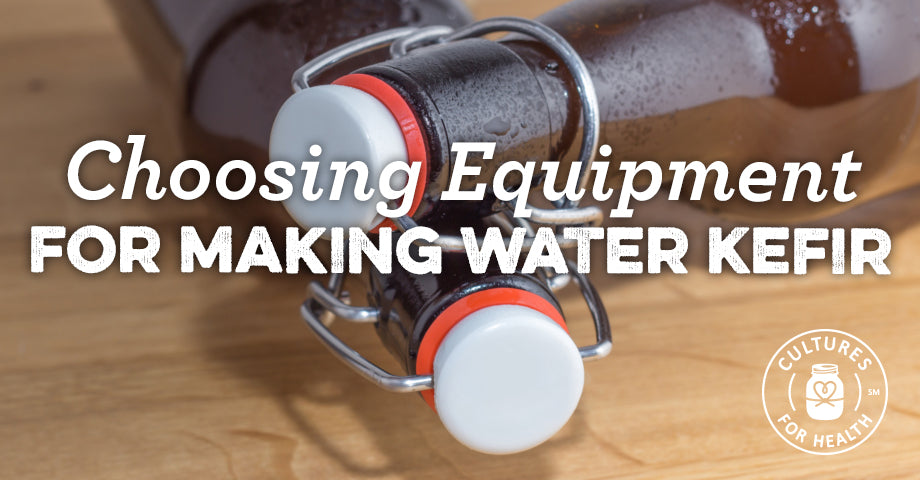
To make water kefir at home, there are only a couple of supplies you will need to gather: a culturing container and a cover for the container. Beyond that everything else is optional.
WATER KEFIR CONTAINER
Material Options
There are many containers to choose from, but some materials are clearly superior to others.
- Glass. Glass is hands-down the best option for making water kefir. Glass won’t react to the acidity of the liquid. Glass doesn’t scratch easily, nor does it contain chemicals such as BPA. Glass containers are relatively easy and inexpensive to obtain. Canning jars are a great option.
- Plastic. Although technically plastic can be used to make water kefir, we do not recommend it for several reasons. First, plastic can be damaged, and scratches in the plastic can harbor foreign bacteria. Second, plastic (even food-grade plastic) often contains undesirable chemicals that can be harmful to the water kefir grains.
- Ceramic. Do not use ceramic, as most of the glazes used to coat ceramic contain lead.
- Porcelain. Food-grade porcelain is generally safe for brewing kefir. Avoid porcelain pieces such as vases or decorative pottery that are not food grade.
- Crystal. Crystal contains lead. Do not use crystal to brew kefir.
- Metal. Metal is generally detrimental to water kefir and should not be used as a culturing vessel or for any item that will have contact with the water kefir grains. The only exception is stainless steel. While we do not recommend using it, some people do have success doing so.
What Size Container Should I Use?
Water kefir can be made in any size jar. When choosing the size of your culturing container, consider how much water kefir you will consume, as each batch of water kefir will culture in 24-48 hours. It is better for the health of the water kefir grains to continually make small batches than to make large batches and take breaks.
COVERING WATER KEFIR DURING FERMENTATION
- The cover should allow the grains to breathe.
- Effective coverings include tight-weave dish towels or fabric, a paper towel, a paper coffee filter, etc.
- The cover should be secured with a tight rubber band, to keep out pests such as ants or fruit flies.
- Avoid loose-weave fabric and screens.
- While a tight-fitting lid should not be used during the fermentation process, it is handy to have a lid for storage after fermentation is complete. Plastic bpa-free lids are available for both wide-mouth and regular-mouth fermentation jars, which are commonly used for culturing water kefir, you can also try our fermentation kit.
OPTIONAL SUPPLIES
- A Plastic Strainer can be useful in removing the water kefir grains from the finished liquid.
- Bottles with a tight seal such as our Grolsch-style Flip-top Bottles work well for making a fizzy finished water kefir.
GET EVERYTHING YOU NEED
Our Water Kefir Starter Kit makes getting started easy. With 5 hand-picked ingredients and supplies you get everything you need to make water kefir. All you supply are kefir supplies like a jar and water.














